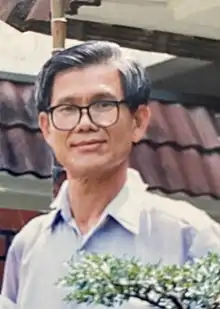Tang Tuck Kan
Tang Tuck Kan[WorldCat 2][WorldCat 3] (Chinese: 鄧德根; pinyin: Dèng Dégēn; Jyutping: Dang6 Dak1 Gan1; Pe̍h-ōe-jī: Tēng Tek-kin, 1934-2012) is a Malaysian artist. Tang was known in the late 60's and 70's for his abstract expressionism, "Hard Edge" space identity in Malaysian Art World.[1] His iconic masterpiece, "49 Squares"[2] is the permanent collection at the National Art Gallery of Malaysia in Kuala Lumpur.[3] Towards his later year, he fused his "Hard Edge" concept with the Chinese I-Ching philosophy, created a modern art masterpieces inspired by his own cultural root.
Tang Tuck Kan 鄧德根 | |||||||||||||||||||||
|---|---|---|---|---|---|---|---|---|---|---|---|---|---|---|---|---|---|---|---|---|---|
 | |||||||||||||||||||||
| Born | Tang Tuck Kan[WorldCat 1] September 10, 1934 | ||||||||||||||||||||
| Died | 2012 (aged 77–78) | ||||||||||||||||||||
| Education | Saint Martins School of Art | ||||||||||||||||||||
| Known for | Painting, drawing, watercolor, mixed media, Hard Edge, modern art | ||||||||||||||||||||
| Movement | Hard Edge, Abstract Expressionism, Malaysian Modern Art, Malaysian Art in the 60s and 70s | ||||||||||||||||||||
| Chinese name | |||||||||||||||||||||
| Traditional Chinese | 鄧德根 | ||||||||||||||||||||
| Simplified Chinese | 邓德根 | ||||||||||||||||||||
| |||||||||||||||||||||
In the early years, Tang pursued his Fine Arts education in UK after he was granted the British Commonwealth Fulbright Scholarship. In 1966, Tang graduated from the prestigious Saint Martin's School of Art in London, UK, which is the Central Saint Martins Arts and Design College under the University of Arts in London.[4] At his later age of life, he created new landscape paintings that married the western composition and watercolor technique to ordinary Chinese painting composition. His landscape paintings quickly became popular in the 80's and 90's. Comfortable as a realist, figurative, portraiture and modern artist, he excelled in all given medium as his artistic presentation.
As an Academician, he was once a senior art teacher at St. Johns Institution, Kuala Lumpur;[5] a lecturer at Institut Teknologi MARA (ITM), which later becomes the Universiti Teknologi Mara (UiTM).[6] Among well-known Malaysian artists who once were his students include Ismail Latiff and Anuar Rashid. Throughout his career, he co-founded Malaysian Institute of Art (MIA)[7] and Kuala Lumpur College of Art (KLCA) with a group of Malaysian Chinese artists.
Tang had solo exhibitions in 1971, 1976 and 1977. He was invited to commission an artwork for the 10th São Paulo Art Biennial in Brazil, 1969, Brazil, Expo '70 in Osaka, Japan[8] and several exhibitions in Canada, Australia[WorldCat 4] and New Zealand.
References
- Sarena, Abdullah (31 October 2017). "Changing Approaches: Installations Produced in the Malaysian Art World". Wacana Seni Journal of Arts Discourse (16): 1–33.
- "Iconic master piece "49 Squares"".
- "National Art Gallery of Malaysia, Kuala Lumpur". art gallery.gov.my.
- "Central Saint Martins". www.arts.ac.uk/colleges/central-saint-martins. 7 June 2018.
- "St. John Institution, Kuala Lumpur". stjohn.edu.my.
- "Institut Teknologi MARA, currently Universiti Teknologi MARA". www.uitm.edu.my.
- "Malaysian Institute of Art". www.mia.edu.my.
- "Expo '70 in Osaka, Japan". www.expomuseum.com/1970.
- "Tang Tuck Kan - Modern Artist". worldcat.org/identities. World Cat.
- 3 contemporary Malaysian artists : Choong Kam Kow, Ahmad Khalid Yusof, Tang Tuck Kan. OCLC 421013209.
- Syed Ahmad Jamal; David Kamansky (January 1, 1988). Contemporary Paintings of Malaysia (1st ed.). Kuala Lumpur: National Art Gallery. ISBN 978-9839572001.
- Exhibition Catalog - Biography. Australia: Raya Gallery. OCLC 271079362.
External links
- Muliyadi Mahamood, Modern Malaysian Art: From the Pioneering Era to the Pluralist Era, 1930s-1990s, Utusan Publications, 2007 pp17
- T. K. Sabapathy, Redza Piyadasa, Modern Artists of Malaysia, Dewan Bahasa dan Pustaka, Ministry of Education Malaysia, 1983 pp20, pp38, pp135
- Vision and Idea: Relooking Modern Malaysian Art, 12 October-12 December 1994 : Exhibition Catalogue, National Art Gallery, 1994 pp36